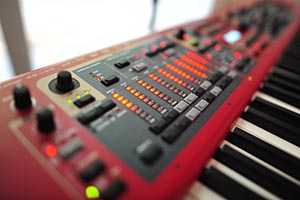Mixing is a complex process in and of itself and implies blending all the sounds into a cohesive piece of music. The process of mixing any instrument has its particularities and intricacies, but in this article, I will focus on mixing keyboards and common mistakes to avoid. So let's see in detail how to mix keys.

1. Choose the right compressor
When we say keys, it doesn’t necessarily mean a piano. The term keys also covers synthesizers or synths for short. And each of the instruments that fall under this category occupies a different part of the frequency spectrum. Synths that use sine wave will have more low frequencies than synths that use saw wave for example, which has a lot of high frequencies. Therefore, when you compress the synth track with a single band compressor it won’t give you the desired results because it works with the track as a whole, not with individual frequencies. For the best results, it is advisable to use a multi-band compressor. It allows you to work with low, mid, and high frequencies separately. It gives you control over the frequency spectrum and allows you to work with precision.
2. Tame your reverb
Many piano plug-ins have reverb settings built-in, and it’s tempting to bring it up to the max or use a reverb plug-in on the live track. And it is understandable reverb always makes everything sound so spacious and full in particular when it comes to pianos. A properly set reverb can liven up a dull recording. However, with reverb, things tend to get out of hand very quickly, and instead of creating space, you will end up creating mud. Especially, if you use one of the presets, like “club” or “big room”. We recommend that you set up your reverb manually and go easy on diffusion. In this case, less is better.
3. Avoid frequency conflicts
One of the keys to a full, professional-sounding mix is panning. Not enough panning is the most common mistake we see in tracks of beginner producers. Usually, tracks with boomy low-end (such as bass, 808, kick drums) should stay in the center, but when it comes to keyboards, they generally benefit from a little bit of panning. It is especially true if you have two or more keyboard tracks that all lie in the same frequency range. Panning these tracks a little bit to the right or left won’t change their sonic quality but will give all of the tracks some room to breathe.
These are not the only mixing keyboard tips.
4. EQing separately from the rest of the tracks
This is relevant for all the instruments you are mixing and goes with the previous point about conflicting frequencies. A mix is a combination of elements that are seen as one complete whole. Often, we start EQing one track and get carried away, making it sound perfect. But your task is to make all the instruments work well together, to give each of them the room to shine. And to do that, you have to work in the context of the whole mix.
5. Mixing live piano
So far, I’ve touched on the basics of mixing keyboards, but I’ve saved the most difficult for last. Working with live pianos can be annoying, as pianos have the biggest range of all the instruments. But the majority of the work here depends on the initial recording process. So make sure to put in the work before you start mixing. Mixing live pianos poses certain difficulties as well, so I recommend that you hire a specialist to do that, as it requires special knowledge and skill.
There you have it, some tips on how to mix keyboards. I hope this article was helpful to you and you have learned something new.
